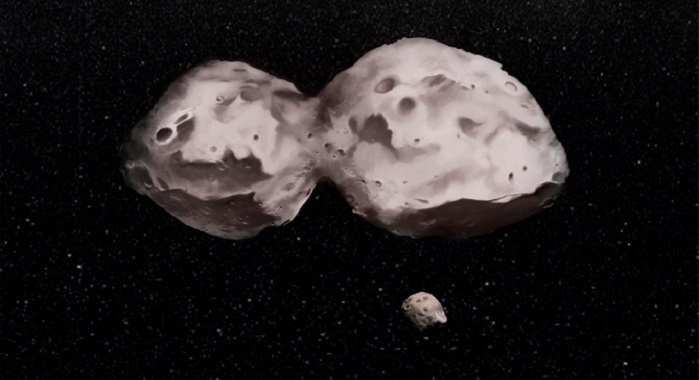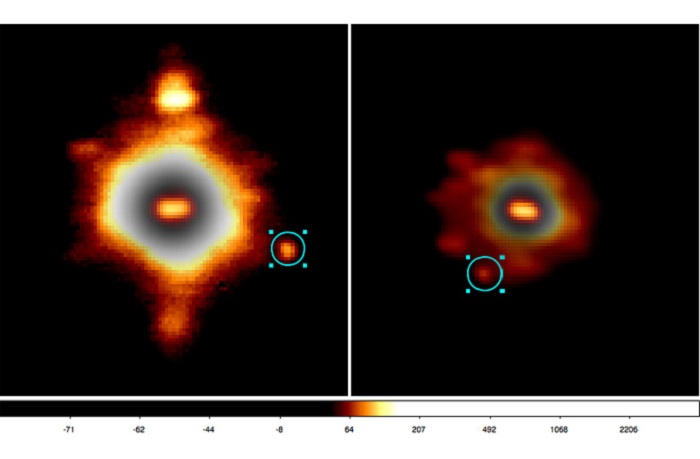.

Artist impression of the Trojan system showing Hektor and its moon.
.
If you had to imagine the weirdest-looking space rock, you might imagine the form of asteroid 624 Hektor, the largest known Trojan asteroid in the solar system. Its bi-lobed shape makes it look like a really big cartoon dog bone, or even a huge peanut. What’s more, despite its knobbly appearance (and just as knobbly gravitational field), it even has its own moon. Now astronomers have taken a long, hard look at this exotic rocky beast and pinned down the bizarre orbit 624 Hektor’s moon, finding that the orbit will remain remarkably stable for billions of years.
The 250 kilometer (155 mile) wide 624 Hektor was discovered in 1907 by German astronomer August Kopff, but the existence of its 12 kilometer (7.5 mile) moon wasn’t revealed until 2006 by a team led by SETI Institute astronomer Franck Marchis. Now, eight years of observations of the motion of 624 Hektor’s natural satellite have finally hit paydirt.
Trojans are a special sub-class of asteroid. Trapped in an orbital resonance with Jupiter, they orbit the sun with the same period occupying two regions 60 degrees ahead and 60 degrees behind the gas giant. 624 Hektor is the only Trojan known to possess its own moon.
The technical hurdles are many when trying to observe Trojan asteroids — they are distant and very faint, requiring time on the world’s most powerful observatories, a hurdle that contributed to the long period of time it took to pin down the moon’s orbit.
“The satellite can be seen only with a telescope like Keck Observatory’s fitted with LSG-AO (laser guide-star adaptive optics), but time on the mighty Keck’s is highly prized and in limited availability,” said Marchis in a SETI Institute news release.
The Keck Observatory, located atop Mauna Kea, Hawaii, consists of two telescopes and in this study, Marchis’ team used the Keck II telescope that is outfitted with a precision adaptive optics system that fires a powerful laser high into the atmosphere, creating an artificial star as seen by the telescope’s optics. The motion of the guide star reveals turbulence in the upper atmosphere (the same effect that causes stars to “twinkle”), which can be actively compensated for, revealing deep space objects that would have otherwise been impossible to resolve from ground-based telescopes.
.

Two adaptive optics observations made in July 2006 and October 2008 with the Keck II telescope. The center of each image shows the elongated shape of Hektor. The small, faint moon is shown in the cyan circle.
.
But it was 624 Hektor’s moon’s orbit that also contributed to the complexities of the observation. “(T)he orbit of the satellite is so bizarre that we had to develop a complex new algorithm to be able to pin it down and understand its stability over time,” added Marchis.
With assistance from the Institut de Mécanique Céleste et de Calcul des Éphémérides (IMCCE) of the Observatoire de Paris, the moon was found to orbit 624 Hektor every 3 days at a distance of 600 kilometers (372 miles) in an ellipse inclined to 45 degrees from the asteroid’s equator
“The orbit of the moon is elliptical and tilted relative to the spin of Hektor, which is very different from other asteroids with satellites seen in the main-belt,” said SETI Institute scientist and co-author Matija Cuk. “However, we did computer simulations, which include Hektor being a spinning football shape asteroid and orbiting the sun, and we found that the moon’s orbit is stable over billions of years.”
With these observations, the researchers have been able to theorize how 624 Hektor came to form in the strange bi-lobe shape and why it has its own moon. Using Keck II and photometric observations of the asteroid since 1957, the researchers managed to refine the asteroid’s shape and they believe the system was created through the slow collision of two asteroids that fused together. The moon was formed from ejecta from this collision.
“We built several models of equal quality from the photometric data, but we favored a model made of two lobes since some of the best adaptive optics observations suggest that the Trojan asteroid has a dual structure,” said Josef Durech, co-author and researcher at the Charles University in Prague.
Also, it appears Hektor didn’t originate at Jupiter’s orbit; it migrated from the Kuiper Belt, a region of icy rocky bodies around the orbit of Pluto, during the early history of the solar system.
“We also show that Hektor could be made of a mixture of rock and ices, similar to the composition of Kuiper belt objects, Triton and Pluto,” said Julie Castillo-Rogez, researcher at NASA’s Jet Propulsion Laboratory in Pasadena, Calif. “How Hektor became a Trojan asteroid, located at only 5 times the Earth–sun distance, is probably related to the large scale reshuffling that occurred when the giant planets were still migrating.”
These fascinating results have been published in the Astrophysical Journal Letters.
Eight years after its discovery, Hektor’s moon remains nameless and Marchis and his team will consider any nomination from the public. If I had to make a suggestion, I’d vote for the name Astyanax, the son of Hector, Crown Prince of Troy and Princess Andromache of Cilician Thebe. Unfortunately, Astyanax has a rather gnarly and untimely death according to Greek mythology, so the discoverers may want to seek out another, more palatable name for their bizarre little asteroid satellite. (That said, I’m still voting for Astyanax.)
NOTE: There is, in fact, an asteroid named 1871 Astyanax, another Trojan asteroid. But my nomination still stands for Astyanax, little moon of Hektor. The IAU may need some convincing, however.
.
Quelle: D-News

